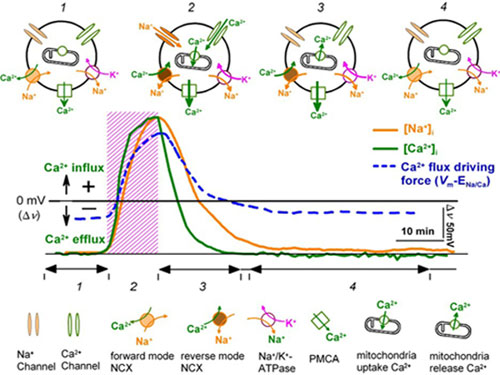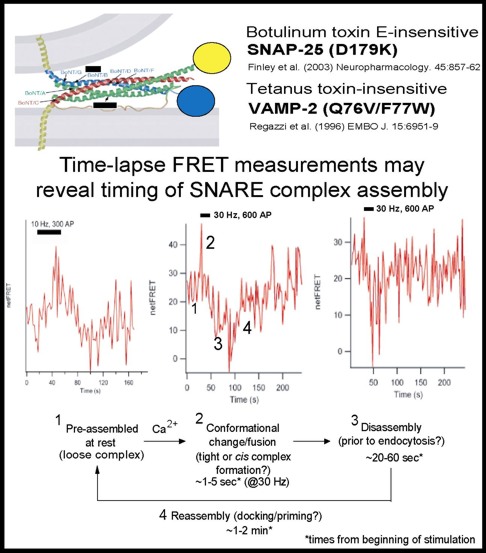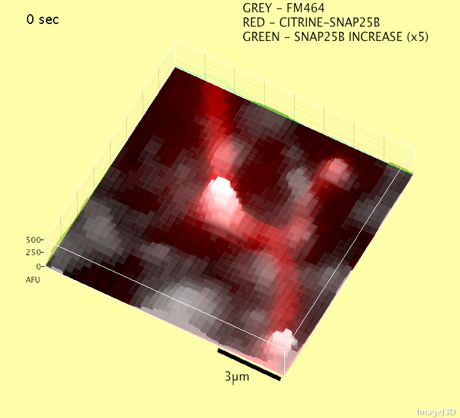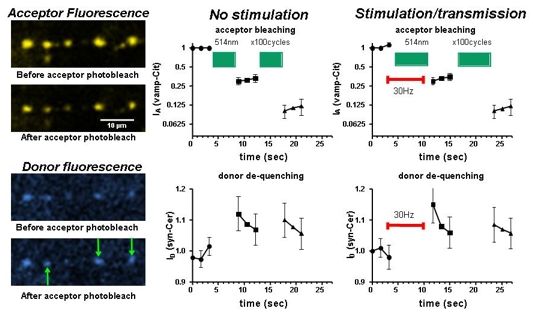Recent and Current Projects
Strong and Weak Synapses
|
|
|
Dramatically different
properties of phasic and tonic synapses. Tonic boutons release 1
quantum per 50 trials at low frequency and facilitate strongly; phasics
release 5-10 quanta per trial and depress. Click
here to Enlarge. |
The
diversity of synaptic properties is
well illustrated by phasic and tonic synapses at crustacean
neuromuscular
junctions. Tonic boutons release almost no transmitter to single
action
potentials, but facilitate tremendously to repetitive stimulation;
phasic
boutons release many quanta to single action potentials, and depress to
repetitive stimulation. The number and structure of active zones
in the
two motor neuron terminals are similar, as is Ca2+ influx
per active zone. We have used photolysis of caged
Ca2+
combined with [Ca2+]i
measurement and focal recording of transmitter release from
single boutons to show that phasic synapses are much more sensitive
than tonic
synapses to a rapid rise in presynaptic [Ca2+]i.
Theoretical analysis and computer simulations of molecular
reaction schemes shows that the differences in response of the synapses
to
steps of [Ca2+]i, single
action potentials, and trains
of action potentials can all be explained by assuming that at phasic
synapses
all the docked vesicles are fully primed and immediately releasable,
while at
tonic synapses almost all docked vesicles are unprimed, but become
primed by
the residual Ca2+
accumulating during a train of spikes (Millar et al.,
2005).
|
|
|
A comprehensive model transmitter release,
comprising calcium influx, diffusion with binding, its activation of
mobilization, priming, and secretion of vesicles, and recovery of
release sites (from Pan and Zucker, 2009). Click
here to Enlarge. |
We have recently produced a comprehensive model of the presynaptic processes controlling transmitter release at phasic and tonic synapses. The model has calcium acting on distinct molecular targets at different locations to mobilize reserve vesicles to docking sites, to prime docked vesicles to enable fast release, and to trigger exocytosis of docked and primed vesicles. Release sites remain refractory for a short time after releasing a docked vesicle, while docking, priming, and fusion machinery is reassembled. The model has provisions for calcium entering presynaptic terminals through voltage-dependent calcium channels during action potentials and diffusing to target sites with binding to mobile and immobile buffers. Model simulations accounted for the kinetics of presynaptic presynaptic [Ca2+]i measurements, synchronous release (EJPs), and asynchronous release (increased mEJP frequency) to trains of action potentials, the dynamics of both facilitation and depression, effects on spike-evoked release of exogenous and photolyzable calcium buffers, release to and recovery from prolonged action potentials, and responses to step rises in presynaptic [Ca2+]i (Pan and Zucker, 2009).
Regulation of Transmitter Release by Epac and HCN Channels
|
|
|
Schematic of the pathways and processes involved
in the regulation of transmitter release by Epac and HCN channels in
hormonal and activity-dependent plasticity. Click
here to Enlarge. |
Serotonin
activates a presynaptic adenylyl cyclase to produce
cAMP, which in turn activates hyperpolarization and cyclic nucleotide
(HCN)-activated ion channels and exchange protein activated by cAMP
(Epac) in
motor nerve terminals, leading to a short-lasting enhancement of
transmitter
release to action potentials. The enhancement is not accompanied by
increasing
resting [Ca2+]i or Ca2+ influx
in action potentials, but requires an intact actin
cytoskeleton (Beaumont
and Zucker,
2000). High levels of presynaptic activity cause a long-term
facilitation
(LTF) in glutamate release to action potentials, due to HCN channel
activation
by the electrogenic Na+/K+
exchanger resulting from excessive Na+ loading
during tetanic stimulation; the synaptic enhancement
involves Ca2+ influx
during the tetanus and local presynaptic protein
synthesis, turnover of the actin cytoskeleton, and a variety of kinases
and
phosphatases that probably regulate protein synthesis (Beaumont et al., 2001; Beaumont et al., 2002; Zhong et al., 2004; Zhong and Zucker,
2004; Zhong et al.,
2005).
|
|
|
Cyan fluorescent protein (CFP) and yellow fluorescent protein (YFP) images from cAMPs expressed in Drosophila neuromuscular junction presynaptic termials. A drop in YFP/CFP fluorescence intensities indicates an increase in [cAMP], which appears to occur uniformly at presynaptic boutons and preterminal axons. Click here to Enlarge. |
We have extended these findings to Drosophila neuromuscular junctions (Cheung et al., 2005) permitting the use of genetic techniques in further analysis. Current experiments are focused on identifying the effector protein(s) activated by Epac, using directed mutations and RNAi knockdown of candidate targets. We are also using a genetically targeted fluorescence resonance energy transfer (FRET)-based sensor of cAMP activity (cAMPs) to characterize the spatio-temporal profile of presynaptic cAMP changes during serotonin action. Future goals include using similar techniques to follow changes in cytoskeleton structure during serotonergic enhancement and LTF, and to track the spatio-temporal profile of presynaptic protein synthesis by injecting mRNA of fluorescently tagged proteins.
PTP at crayfish NMJs
|
|
|
Multiple systems
regulating presynaptic [Ca2+]i in PTP. Click
here to Enlarge. |
Post-tetanic potentiation (PTP) is a form of homosynaptic plasticity following repetitive activity in which the efficacy of synaptic transmission grows over a period of several minutes of activity and decays slowly (t » 2 min) afterwards. We have previously shown that PTP is caused by a post-tetanic plateau of residual Ca2+ -- resulting from leakage of Ca2+ from tetanically loaded mitochondria and reverse mode operation of the plasma membrane Na+/Ca2+ exchange pump (Tang and Zucker, 1997; Zhong et al., 2001). We have also detected increases in intracellular Ca2+ concentration ([Ca2+]i) transients in crayfish motor nerve terminals to brief AP trains following induction of PTP and LTF. We recently discovered (Minami et al., 2007) that this is due to increases in Ca2+ influx through Na+/Ca2+ exchangers acting in reverse mode during action potentials, and we demonstrated that this regulation of a Ca2+ pump by neural activity is unrelated to PTP and LTF.
SNARE interactions by FRET in secretion and recovery
|
|
|
Dynamic FRET
between
VAMP-2B-monomeric cerulean (a CFP on the N-terminus) and
SNAP-25B-monomeric citrine (a
YFP) during and after tetanic stimulation of cultured rat hippocampal
neurons transfected with labeled toxin-insensitive proteins.
FM4-64 destaining confirmed that secretion to tetanic stimulation was
normal in imaged boutons. Click
here to Enlarge. |
Exocytosis
of vesicles from the presynaptic terminal is mediated
by a set of vesicle and plasma membrane associated proteins,
collectively termed the SNARE complex. interactions between
proteins that
comprise this molecular machine (synaptobrevin, SNAP-25 and syntaxin)
are critical in the fusion of vesicles, making them important
factors in regulating secretion and recovery. we
are using fluorescence resonance energy transfer (FRET)-based recording
methods to examine interactions between specific
CFP and YFP N-terminal-tagged SNARE protein pairs before, during, and
after vesicle
exocytosis in hippocampal neurons. We have developed a novel
multichannel imaging system, and detected FRET signals
corresponding to the assembly of SNAREs prior to secretion,
conformational changes in the SNAREs accompanying exocytosis, and the
disassembly of SNAREs following their dispersion to the margins of
active zones and prior to endocytosis.
|
|
|
A three-channel
movie showing release of synaptic vesicles from a presynaptic bouton of
a cultured rat hippocampal neuron on stimulation at 30 Hz for 20 s,
along with the simultaneous dispersion of the SNARE protein SNAP25 from
the central active zone to its periphery. Vesicles prestained with
FM4-64 are shown as grey, and their release appears as dimming of the
grey background. The SNAP-25 labeled with citrine on its N-terminal is
colored red, and it disperses as vesicles fuse in the active zone and
the associated SNAREs disperse to the periphery. Green
pseudocolor shows increases in SNAP-25 fluorescence, marking areas into
which the SNAP-25 moves on stimulation. Click
here to play the movie ... |
We
have observed dispersal of the plasma membrane SNARE proteins SNAP-25
and syntaxin, as has been reported for vesiclular VAMP, beginning
immediately after vesicles fuse on stimulation, and preceding the loss
of FRET signalling SNARE disassembly. This may represent
dispersion of intact SNAREs untethered after vesicle fusion before they
are disassembled at active zone edges.
|
|
|
Syntaxin
is labeled with cerulean (FRET donor) and VAMP with citrine (FRET
acceptor), both on C-terminals. Photobleaching citrine dequenches
cerulean fluorescence (green arrows),
revealing a resting FRET. Photobleach (technically,
photoinactivation) is partly reversible. Stimulated
secretion results in additional FRET, as vesicles fuse and SNAREs
undergo trans-cis transformation. Enhanced loss of dequenced
donor fluorescence after stimulation may reflect dispersion of syntaxin
from central active zone from which fluorescence is measured.
Click
here to Enlarge. |
We
have also detected interactions between the C-terminal labeled proteins
VAMP and syntaxin. Vesicle fusion leads to a trans-cis transformation of the
SNAREs bridging docked vesicles and the plasma membrane, and the
apposition of the C-terminal labels on vesicle fusion induces new FRET
between them. A resting FRET is also present, due to orphan VAMP
left behind from prior activity, still assembled with syntaxin in
SNAREs.

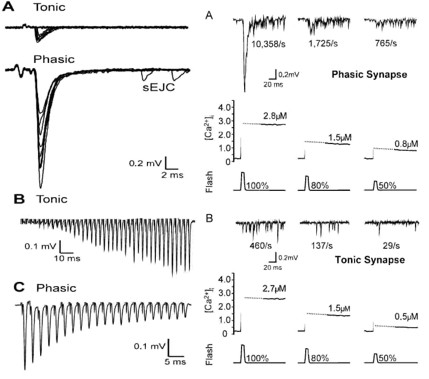
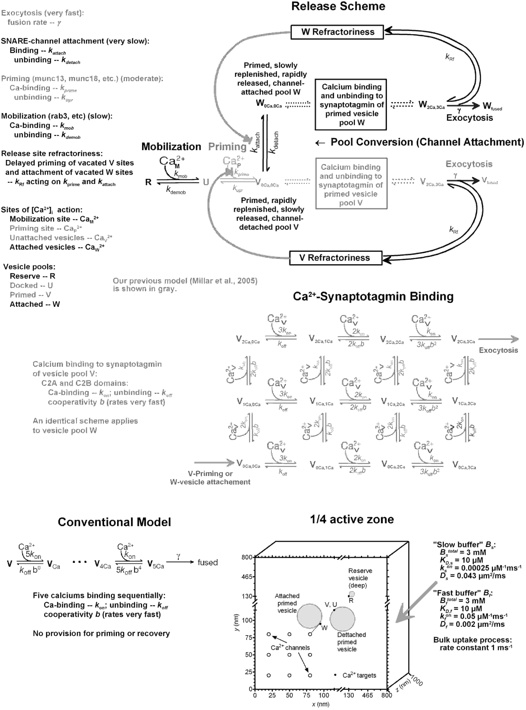
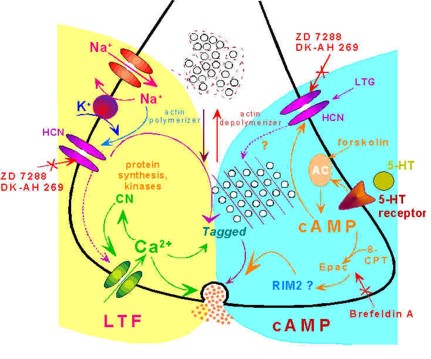
![[cAMP] changes induced by forskolin](Arunesh_Web_Page__small.jpg)
